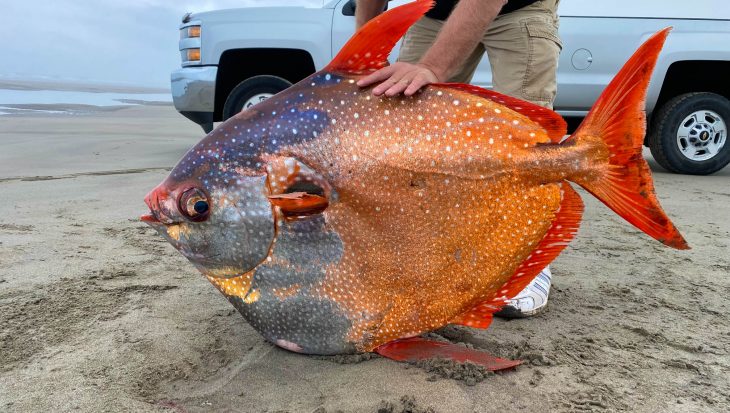Opah, the first truly warm-blooded fish
The opah, also known as the moonfish or sunfish, has made waves in the scientific community due to its unique ability to regulate its body temperature, making it the first known truly warm-blooded fish. This remarkable adaptation has opened up new avenues of research and has challenged our understanding of how fish cope with the temperature extremes of the deep ocean.
The opah, Lampris guttatus, is a large, deep-sea dwelling fish that can be found in oceans around the world. Its distinctive appearance, with a round, flattened body and striking red-orange coloration, has earned it the nickname “sunfish” or “moonfish.” Despite its somewhat peculiar appearance, opah remained relatively understudied until recent years.
In 2015, a groundbreaking study published in the journal “Science” revealed the opah’s extraordinary ability to generate and maintain its own body heat. This discovery challenged the long-held belief that all fish are cold-blooded, unable to regulate their internal temperature, and entirely reliant on their environment to stay warm or cool.
Opahs possess a unique system that allows them to maintain their body temperature above that of the surrounding water. This trait, known as endothermy, is commonly found in mammals and birds but was previously unknown in fish. Endothermic animals can regulate their body temperature independently, giving them a significant advantage in environments with fluctuating temperatures.
To achieve this feat, opahs have a specialized network of blood vessels called a “counter-current heat exchange system” that helps trap and circulate heat throughout their body. Essentially, warm blood from their core helps heat up cold blood returning from the gills, preventing heat loss to the surrounding water. This internal heating mechanism enables opahs to maintain a body temperature of about 5 degrees Celsius (9 degrees Fahrenheit) above the ambient water temperature.
The discovery of warm-blooded opahs has far-reaching ecological implications. This adaptation allows opahs to thrive in the cold, dark depths of the ocean, where most other fish would struggle to survive due to the extreme temperature gradients. This could explain why opahs are often found at depths ranging from 150 to 1,300 meters (500 to 4,260 feet) below the ocean’s surface.
Opahs are opportunistic predators, primarily feasting on squid and other fish, and their warm-blooded physiology likely gives them a competitive edge when hunting in these frigid depths. The ability to maintain an elevated body temperature allows them to react more quickly and efficiently, giving them an advantage in capturing prey and escaping from predators.
The newfound status of opah as a warm-blooded fish has also raised concerns about their vulnerability to climate change. As ocean temperatures rise due to global warming, the temperature gradients that opahs rely on to maintain their advantage could become less pronounced. This could potentially impact their ability to survive and thrive in their deep-sea habitats.
Additionally, opahs have become a target for commercial fishing due to their large size and flavorful meat. Their newfound status as a warm-blooded species may increase their desirability, potentially leading to overfishing and population decline if not managed properly.
The opah, the first truly warm-blooded fish, has captivated scientists and marine enthusiasts alike with its remarkable adaptation to the extreme conditions of the deep ocean. Its ability to regulate its body temperature has opened up new avenues of research into the physiology and ecology of fish, challenging our understanding of life in the ocean’s depths. As we continue to study and learn from this remarkable species, it becomes clear that there is still much to discover about the hidden wonders of the deep sea and the creatures that call it home.
Hits: 6










